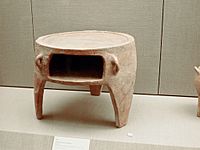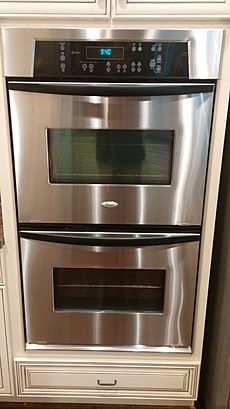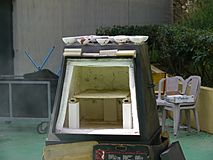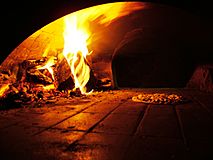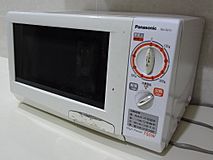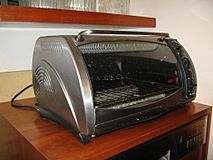Oven facts for kids

Ovens are closed, heated containers which are used for heating, baking, and drying. It is used the most often in cooking and pottery. They provide even, dry heat to all surfaces of food inside them. An indoor oven can have an electric heating element, or be fired by natural gas or coal. Outdoor ovens are often made of brick or clay and are buried in hot coals. An oven which is used for making pottery is called a kiln. An oven used for heating or industrial processes is called a furnace. They are hot inside, and often things come out of them hot.
Contents
History
The people in the settlements of the Indus Valley Civilization were the first to have an oven inside of their mud-brick houses by 3200 B.C. People who study the history of food give credit to the Greeks for making the baking of bread into an art. A type of oven called Front-loaded bread ovens were created in ancient Greece.
Types of ovens
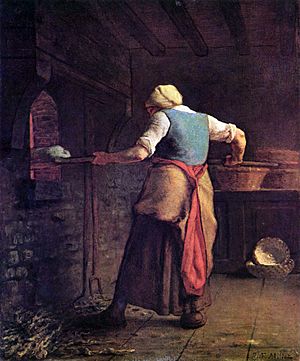
- Double oven: a built-in oven fixture that has either two ovens, or one oven and one microwave oven. It is usually built into the kitchen cabinet.
- Earth oven: An earth oven is a pit dug into the ground and then heated, usually by rocks or smoldering debris. Historically these have been used by many cultures for cooking. Cooking times are usually long, and the process is usually cooking by slow roasting the food. Earth ovens are among the most common things archaeologists look for at an anthropological dig, as they are one of the key indicators of human civilization and static society.
- Ceramic oven: The ceramic oven is an oven constructed of clay or any other ceramic material and takes different forms depending on the culture. The Indians refer to it as a tandoor, and use it for cooking. They can be dated back as far as 3,000 BC, and they have been argued to have their origins in the Indus Valley. Brick ovens are also another ceramic type oven. A culture most notable for the use of brick ovens is Italy and its intimate history with pizza. However, its history also dates further back to Roman times, wherein the brick oven was used not only for commercial use but household use as well.
- Gas oven: One of the first recorded uses of a gas stove and oven referenced a dinner party in 1802 hosted by Zachaus Winzler, where all the food was prepared either on a gas stove or in its oven compartment. In 1834, British inventor James Sharp began to commercially produce gas ovens after installing one in his own house. In 1851, the Bower's Registered Gas Stove was displayed at the Great Exhibition. This stove would set the standard and basis for the modern gas oven. Notable improvements to the gas stove since include the addition of the thermostat which assisted in temperature regulation; also an enamel coating was added to the production of gas stoves and ovens in order to help with easier cleaning.
- Masonry oven: Masonry ovens consist of a baking chamber made of fireproof brick, concrete, stone, or clay. Though traditionally wood-fired, coal-fired ovens were common in the 19th century. Modern masonry ovens are often fired with natural gas or even electricity, and are closely associated with artisanal bread and pizza. In the past, however, they were also used for any cooking task that required baking.
- Microwave oven: An oven that uses micro radiation waves as a source of heat in order to cook food as opposed to a fire source. Conceptualized in 1946, Dr. Percy Spencer allegedly discovered the heating properties of microwaves while studying the magnetron. By 1947, the first commercial microwave was in use in Boston, Mass.
- Toaster oven: Toaster ovens are small electric ovens with a front door, wire rack and removable baking pan. To toast bread with a toaster oven, slices of bread are placed horizontally on the rack. When the toast is done, the toaster turns off, but in most cases the door must be opened manually. Most toaster ovens are significantly larger than toasters, but are capable of performing most of the functions of electric ovens, albeit on a much smaller scale.
- Wall oven: Wall ovens make it easier to work with large roasting pans and Dutch ovens. A width is typically 24, 27, or 30 inches. Mounted at waist or eye level, a wall oven eliminates bending. However, it can be nested under a countertop to save space. A separate wall oven is expensive compared with a range.
- Deck oven
- Rotary oven
- Steam oven
- Convection oven
- Tunnel oven
-
A wood-fired pizza oven, a type of masonry oven
Images for kids
See also
 In Spanish: Horno para niños
In Spanish: Horno para niños


